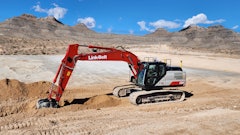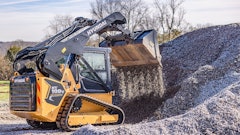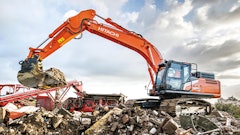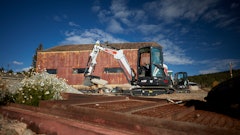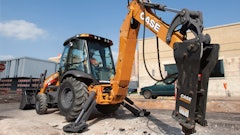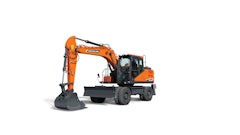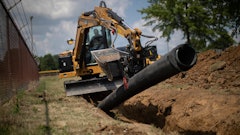
Onboard monitors on current generation excavators provide a wealth of information and capability that can increase productivity, reduce fuel consumption and enhance safety on the jobsite. The monitors often interface with modern electrohydraulic systems to provide semi-autonomous functions and customized capabilities that make novice operators more efficient while reducing fatigue in more experienced operators.
There is a wealth of information at your fingertips. For instance, the monitors on Kobelco excavators allow you to monitor the machine’s hydraulic work mode, attachment flow and pressure settings, diesel exhaust fluid (DEF) level, real-time fuel consumption, fuel efficiency and machine surroundings, according to George Lumpkins, product marketing and developing general manager.
 Kobelco excavators allow you to monitor your hydraulic work mode, attachment flow and pressure settings, DEF level, real-time fuel consumption, fuel efficiency and machine surroundings.
Kobelco excavators allow you to monitor your hydraulic work mode, attachment flow and pressure settings, DEF level, real-time fuel consumption, fuel efficiency and machine surroundings.
Similar to advancements in computers and smartphones, the advancement of machine control interfaces is making the machines more powerful. “Operator interfaces are advancing greatly, creating a more productive jobsite,” says Matthew McLean, product manager, Volvo Construction Equipment.
Many OEMs are working to improve the ergonomics of advanced excavator interfaces. “Volvo continuously strives to improve productivity by making more functions available on the joysticks, thereby minimizing the number of times the operator has to reach for other controls,” says McLean. “Volvo also simplified operation by deleting switches and incorporating the controls into the main display. Rather than having to hunt all over the cab for the right switch, most functions can be accessed through the keypad located directly below the operator’s right hand. In instances where certain devices are hard to reach (like the radio), a shortcut panel has been located close to the keypad.”
Common setups can be stored in the machine’s memory for ease of setup and operation. Volvo offers in-cab monitors that can store hydraulic settings for up to 20 attachments.
“The benefits are numerous for customers who need to switch attachments frequently — for example, a general contractor who was using a thumb at a site one day, but the next day needs a tilting bucket at another site. Special application customers, such as those who do demolition, like to preset hydraulic pressure and flow for their multiple attachments,” McLean notes. “In addition, some customers don’t need to switch attachments, but still like this function because the in-cab monitor setting allows the operators to set up pressure and flow in great detail.”
He adds, “In general, without the in-cab monitor system, pressure and flow may not be ideal for the application and should be adjusted manually.”
Caterpillar recently introduced its Next Generation 20-ton excavators, with the 320 and 323 featuring advanced electrohydraulic systems. To simplify operation, Caterpillar designed a new cab layout that incorporates a touchscreen interface.
“The cab has been redesigned completely from the ground up,” says Brian Stellbrink, marketing professional, Caterpillar. “We moved all the controls on the machine forward of the operator. There are a lot of different buttons and controls in that interface that the operator needs to work with.” Placing all of those in front of the operator results in a very ergonomic layout.
Touchscreen navigation is patterned after a smartphone or tablet. “The navigation structure is very similar to what you would expect from a lot of consumer products today,” says Stellbrink. “What that means for an operator in the seat is it is very simple, easy and intuitive to work through different menu structures.
“Operators also have the option of shortcut keys,” he continues. “For some of the most commonly used items, we actually have a series of shortcut keys along the right-hand side. They can activate those rather quickly and easily rather than having to go into that screen.”
The customizable control setting can be tied to individual operators. “Whether it is a key fob, a pass code or an app on your smartphone, the machine can link to that operator,” says Stellbrink. “The machine will re-configure itself to the settings or preferences of that operator. For example, operators sometimes operate the machines in different joystick pattern controls.”
He adds that 10 buttons on the joystick are reconfigurable. “If the operator is using different functions quite often, they can reconfigure those buttons. Those settings are stored,” he comments. “So when they hop in that machine the next morning, the excavator knows the operator. It knows the operator’s settings and it sets the buttons up for the operator. It is all done automatically.”
 The operator can view the status of all major components and functions through the Hyundai interactive, adjustable touchscreen monitor. The operator can control these systems via push buttons, the touch screen monitor itself or a haptic control that is positioned right at his fingertips.
The operator can view the status of all major components and functions through the Hyundai interactive, adjustable touchscreen monitor. The operator can control these systems via push buttons, the touch screen monitor itself or a haptic control that is positioned right at his fingertips.
“The operator can view the status of all major components and functions through the Hyundai interactive, adjustable touchscreen monitor,” says Fuller. “The operator can control those systems and functions — including hydraulic pressure and flow, power modes, attachment settings — via push buttons, with the touchscreen monitor itself or with a haptic control that is positioned right at his fingertips. Haptic control is an automotive-style system that delivers tactile feedback by using pulses to help guide the operator through all menu sections of the monitor.”
Manufacturers have worked to simplify navigation. “On Hyundai excavators, the operator has the choice of navigating the monitor using up-or-down or side-to-side arrows, by lightly pressing on the touchscreen monitor and dragging a finger up or down when moving through the different menus or by using the haptic control,” says Fuller. “We have what we call key-on mode which allows an operator to save each of his individual settings in the monitor. This way he does not have to reset it each time he fires the machine up.”
Commonly used settings can be stored for future use. “The operator can set a name for each attachment and save as many as 10 single-acting and 10 double-acting settings, including the pressure and flow for each of the 20 settings,” says Fuller. “The monitor also displays an inclinometer, which indicates the machine’s level status in real time for enhanced safety when lifting loads, and improved grading accuracy.”
While these new system interfaces provide a lot of detailed information, the goal is to simplify operation and not confuse the operator. “Interfaces are great, but they can be confusing, which is why Kobelco excavators include performance and control features that do not require operator input,” says Lumpkins.
Some of these include automatically matching pump power settings to the engine, a swing priority system to prioritize side wall digging, etc. As a result of the modern electrohydraulic systems, many functions can now be simplified to ease the operator’s workload.
Semi-Autonomy Gains Traction
“Kobelco has worked closely with Trimble for several years to develop one of the most advanced machine control systems on the market today,” Lumpkins states. This interface is used to control simple grade control functions all the way up to full-blown 3D GPS systems. “The system does not use specialized (and potentially expensive) electronic sensor cylinders or mechanical controlled position sensors, but newly developed state-of-the-art gyroscopic sensors. These new sensors are similar to those used in modern airliners and stability systems on automobiles.”
 Trimble has recently added controls to the boom and the bucket of an excavator. By flicking a switch on the control lever when the excavator gets close to grade, the system takes over the boom and keeps the bucket flat to the design surface.
Trimble has recently added controls to the boom and the bucket of an excavator. By flicking a switch on the control lever when the excavator gets close to grade, the system takes over the boom and keeps the bucket flat to the design surface.
“We are finding it is a lot easier for new operators to use that excavator as a result of that automation,” he adds. “You don’t have to be a 30-year veteran to be able to operate an excavator.”
Trimble is leveraging user familiarity with smartphone technology to make the system easy to use. “We have brought that experience onto our machine control platforms,” says Drake. “The day-to-day interface with our new display of our onboard computer is very much like you would expect from your iPhone or Android phone.”
The Next Generation Cat 320 and 323 excavators come standard with Cat Connect Technology, which includes Cat Grade Control with a 2D grade and slope system. “Cat Grade with Assist is semi-automation of some of the functions that helps the operator stay on grade,” says Stellbrink. “For example, if they are digging a 6-ft. cut, they set the 6-ft. cut in the monitor digging down to grade and that machine will actually step in and automatically prevent them from over-digging. [This allows] that operator to quickly and confidently get to grade and, more importantly, stay on grade the first time, preventing costly over-digging without using GPS.”
[VIDEO] Caterpillar Grade Assist Reduces Manual Inputs, Errors and Fatigue
Cat Grade with Assist enables the operator to set and quickly and confidently get to grade. “When it sees the opportunity, the machine will automatically modulate the boom and the bucket functions,” says Stellbrink. “If you have machine technology via Assist... that allows the operator to more quickly get to grade more confidently, and also helps lesser experienced operators learn faster and be able to dig a high-quality final product with more limited experience. We need machines that are going to help make average operators better and make very good operators less fatigued.”
Another technology on the 320 and 323 is the onboard scale system, known as Payload. “We are using sensor technology to know what is in the bucket at any given time,” says Stellbrink. “The operator knows what is in the bucket, they know what is going in the truck and the cumulative totals of what is in the truck. You can put in the most material without overloading it.”
Caterpillar also allows machine movements to be limited. “E-Fence allows the operator to very quickly set certain boundary limits,” Stellbrink explains. “For example, if they are working alongside traffic and they want to prevent the machine from swinging off to the right, basically working to the left 180° or more, they can easily set a swing fence. Now that machine will not allow that operator to go past a certain point.”
This gives the operator the ability to quickly and easily set up different boundary conditions when they are working around obstacles. Take the E-ceiling capability, for example. “You can set a ceiling height quickly and go about your work. It will prevent the front of the machine from going above that defined point,” says Stellbrink.
There are also floor limits for underground utilities and a front limit that you can set if you are digging up against structures. “You can set a limit out in front of you and the front of the machine will not go beyond that set point,” says Stellbrink.
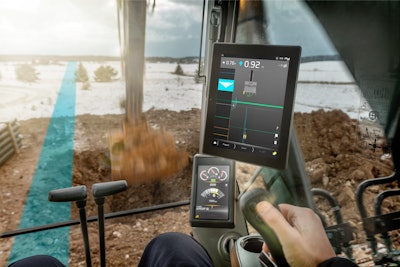
[VIDEO] Volvo Dig Assist: Automate Grade Checking with Your Excavator
“Dig Assist is one of the most useful new technologies integrated with in-cab controls,” he asserts. “It offers many benefits and quick ROI [by] making operators more accurate when digging and reducing rework, working safely by giving visual and audible warnings with height and depth alarms and reducing labor costs by minimizing the amount of checking and rechecking for depth and slope accuracy.”
The technology is currently 2D, but perhaps not for long. “Looking forward, there is the possibility for 3D modeling that will allow for uploading a CAD model for an entire jobsite onto the system,” McLean predicts. “Overall, as can be seen across machines from dozers to motor graders and now excavators, the industry is rapidly moving into a semi-autonomous state of working.”
Optimize Fuel Efficiency
The combination of electrohydraulic controls and advanced in-cab monitors allow operators to monitor and optimize fuel consumption.
“One way Volvo has decreased fuel usage is by having the button that activates its proprietary ECO mode function on the main keypad,” says McLean. In addition to the ECO mode, which utilizes the computer to keep the machine running just below the threshold of relief pressure, operators can use screens on the main display to precisely monitor their current and average fuel consumption.

“Along with our different Eco modes or Eco gauge, Hyundai offers one-touch auto-deceleration, allowing the engine to return to idle just four seconds after any operation has ceased,” he adds.
Kobelco also offers an ECO gauge for efficiency monitoring. “A green indicator provides fuel efficiency feedback so that operators can easily see their effective fuel savings in real time,” says Lumpkins. “Performance modes and easy mode selection provide operators with great fuel savings and the best of both worlds in a single finger touch.”
Operating modes can be adjusted to meet jobsite conditions. “All North American Kobelco excavators start in H-Mode (high-performance mode) due to market demand for productivity,” says Lumpkins. However, with a touch of a button, operators can access S-Mode (standard mode) or ECO-Mode (economy mode), which reduce the fuel consumption of Kobelco excavators to better match job conditions.
Three additional modes prioritize digging, breaker or hammer usage, as well as shear or thumb operation. “If using a breaker or hammer, the return oil is routed directly to the main hydraulic tank to reduce back pressure and reduce fuel consumption,” says Lumpkins.















